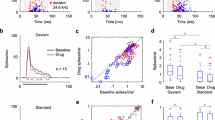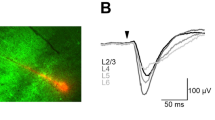Abstract.
The role of γ-aminobutyric acid (GABA)ergic inhibition in shaping the excitatory frequency tuning of 74 neurons in the superior olivary nucleus of the leopard frog, Rana pipiens, was studied using iontophoretic application of the GABAA receptor antagonist, bicuculline methiodide. For 37 neurons, bicuculline application broadened and/or changed the configuration of the excitatory frequency-tuning curve. Results indicate that GABA-mediated inhibition not only sharpens the tuning curves of neurons but also plays a critical role in creating new frequency tuning properties in the superior olivary nucleus. Bicuculline application affected other neuronal response properties as well. Spontaneous firing rate increased 11–338% for 18 of 59 neurons. For 32 of 58 neurons there was an increase in stimulus-evoked discharge rate and a change in rate-level function. There was no qualitative effect on the discharge pattern of 60 neurons, though 2 tonically responding neurons did show an increase (>30%) in response duration. Additional roles for GABAergic inhibition in monaural signal analysis are discussed.
Similar content being viewed by others
Author information
Authors and Affiliations
Additional information
Electronic Publication
Rights and permissions
About this article
Cite this article
Zheng, W., Hall, J. GABAergic inhibition shapes frequency tuning and modifies response properties in the superior olivary nucleus of the leopard frog. J Comp Physiol A 186, 661–671 (2000). https://doi.org/10.1007/s003590000119
Accepted:
Published:
Issue Date:
DOI: https://doi.org/10.1007/s003590000119




